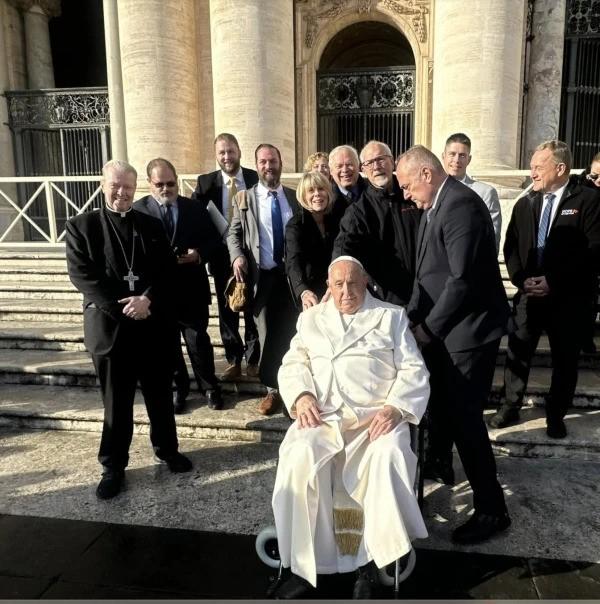Catholic Bishop Lauds ‘Hope From The Margins' For Evangelization
The Catholic Land Movement seeks to foster family life, faith, and farming as part of evangelizing rural life.

Bishop Edward Scharfenberger of Albany, New York, returned from the Vatican excited by a new initiative he calls “hope from the margins” to embolden Catholics working in evangelization and social justice.
He said in an interview that this was the second trip he took to Rome this year, accompanied by a dozen groups from his diocese to find resources and cooperation among similar groups elsewhere and at the Vatican. The trips were inspired by a visit he made several years ago to Mexico City, where he saw the work of Hope for the Poor, a non-profit for the “poorest of the poor,” he said. “I didn’t know such operations existed,” he said about the Nov. 30 - Dec. 6 visit.
Scharfenberger witnessed with the group the horrific conditions in which thousands of people work in the garbage dump of Mexico City, which produces the refuse of 9 million people. They are separated from society because of the stench of refuse, he said, that infuses their skin and bodies. Some are even refused medical care, baby delivery, and education.
Scharfenberger said he was impressed by Hope for the Poor’s work in Mexico, which provides material aid and affirms the dignity of the poor. It seeks, he said, to “bring hope to those people through their own desires and their own faith. Unlike some missions, the primary purpose is not to deliver goods, but to encounter them as human beings. That’s the dynamism that completely grabbed me.” The experience of encountering the marginalized also helps to evangelize those living in the center, he said.
“They effectively evangelize and help us discover the humanity of people living on the margins,” he said. The moniker “hope from the margins” occurred to Scharfenberger as a result. This germ of an idea clarified the purpose of the trips to the Vatican. “This is a movement growing out of a common vision in sync with Pope Francis’s teachings about going out to the peripheries and bringing them to the center,” he said while referring to the pontiff’s Laudato Si encyclical. The participants in visits, he said, share a common experience of witnessing life as lived among the poor and marginalized, however defined.
Among those who have gone with the bishop to Rome were Dr. Joseph Dutkowsky, an orthopedic surgeon specialized in disabled patients, Jeff Runyan of Focus 153 and Encounter Travel, and award-winning fashion photographer Rick Guidotti, each of whom have sought to emphasize the dignity and humanity of marginalized people, the bishop said.
A consultation with Cardinal Michael Czerny of the Dicastery for Human Development at the Vatican,revealed the dicastery’s interest in helping other bishops to address likewise the marginalized. To broaden the perspective of the group organized by Scharfenberger, the Catholic Land Movement was added, Scharfenberger said, because it incorporates the pope’s focus on caring for creation and justice. “The common thread among them is a passion for people on the margins and that they have important stories to be told,” he said.
Based in rural upstate New York, Michael Guidice, known online as Michael Thomas of Sharon, leads the Catholic Land Movement, which traces its lineage to the Catholic Land Associations of 100 years ago in England. Fr. Vincent McNabb, a Dominican friar lauded by beloved English author Gilbert Keith Chesterton, was well known in English-speaking countries for his public defense of the Catholic faith and ecumenism. McNabb advocated landownership and self-reliance among the poorer classes in line with Pope Leo XIII’s encyclical Rerum Novarum, which called "every minister of holy religion... to bring to the struggle [for broad distribution of property] the full energy of his mind and all his powers of endurance."
“This movement is growing by leaps and bounds and hard to keep up with,” Guidice said. “The Spirit is moving among laity, religious, and parish communities, and we’re doing our best to put together the conference,” he said in reference to an upcoming meet-up. Faithful Catholics in the U.S. are seeking to reclaim not only timeless farming methods, he said, but also foster autonomy in providing for their families, not only physically but also spiritually.
“The Catholic Land Movement pushes to create homesteads. Its focus is on instruction and organization so that people can return productivity to the household. It is putting households and families back into the production of primary things,” he said. Referring to his own family farm, Guidice said, “Sometimes, affiliated people are commercial farmers, but my farm is a homestead, which means that my primary focus is to produce the primary things for my own sustenance.” He said affiliated families get together to help each other, and teach breadmaking, canning, carpentry and sewing.
Its conferences seek to form friendships and connections, as well as impart new skills, such as stone masonry and beekeeping. Opportunities for Mass and congregational prayer are also featured. It is forming state chapters.
“The point of the Catholic Land Movement is not to serve the market economy. It’s more to teach people to return production to their own property and household, which is a core tenet of Catholic social teachings going back to Pope Leo XIII and elsewhere,” Guidice said.
Bishop Scharfenberger said in the interview that the group, including Guidice, met Pope Francis briefly in Rome and delivered to him a description of their activities. He envisions the beginning of a wider movement to “bring the margins to the center.” He said “Evangelization is at the heart of this: evangelizing from the margins.”